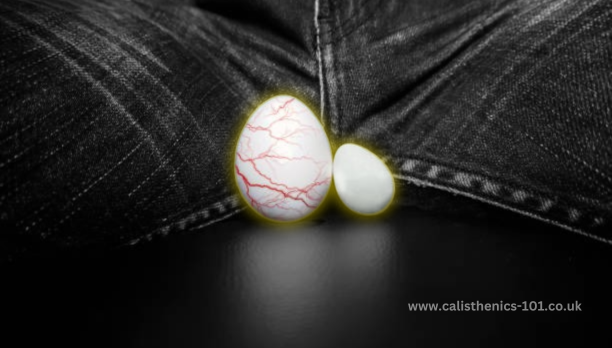Embarking on a journey towards fitness often involves exploring various exercise routines.
Calisthenicss, a form of workout that relies on body weight, has gained popularity for its simplicity and effectiveness. However, for individuals dealing with varicocele, a condition affecting the veins in the scrotum, the compatibility of Calisthenicss raises questions.
In this article, we delve into the realm of Calisthenicss and its potential implications for those with varicocele. While seeking a path to enhanced fitness, understanding the interplay between this exercise regimen and the specific health concern is crucial.
Table of Contents
Understanding What Is Varicocele
Varicocele is a medical condition affecting the blood flow in the testicles. It occurs when the veins in the scrotum become enlarged and twisted, causing blood pooling. This disrupts normal testicular blood circulation, potentially leading to discomfort or testicular pain. The condition is similar to varicose veins in the legs.
Varicoceles are commonly found on the left side due to the way blood flows in the scrotum. They might impact fertility in some cases. Medical evaluation is advised if testicular pain or other symptoms gradually increase.
Is It Okay To Workout With Varicocele?
Engaging in regular workouts with varicocele requires careful consideration of the exercises performed. While some activities, like weight lifting, could exacerbate varicocele symptoms due to increased abdominal pressure, others, like yoga inversion exercises, might potentially offer relief. Varicocele pain can stem from blood pooling, and exercises promoting muscular and hip mobility, can aid in better blood circulation, potentially alleviating discomfort.
When considering varicocele exercises, remember that a low-impact workout can improve circulation and help provide relief. But consulting a healthcare professional before commencing any exercise regimen is essential, particularly if varicocele pain or discomfort is already present.
They can provide personalised guidance and suggest the right exercise type. Ultimately, a balanced approach to exercise, emphasising movements that enhance blood circulation while minimising strain, is key to making an informed decision on working out with varicocele.
Can I Do Push-Ups In Varicocele?
In the case of varicocele, engaging in push-ups requires consideration of muscle balance and pressure. Push-ups can promote muscular mobility, potentially aiding blood circulation and alleviating varicocele discomfort. However, caution is advised. Performing push-ups with too much pressure or strain on the abdomen might exacerbate symptoms due to increased abdominal pressure.
It’s recommended to avoid vigorous exercise immediately after eating, as a full stomach can contribute to discomfort during physical activity. Start with a moderate number of push-ups, focusing on proper form and breathing.
Consulting a healthcare professional before incorporating push-ups or any exercise routine is wise, as they can provide advice based on the severity of the condition and your individual health profile.
Does Lifting Heavy Affect Varicocele?
Lifting heavy objects can potentially impact varicocele due to its influence on the affected testicle and surrounding area.
When lifting heavy things, particularly if done improperly, there’s a high risk of increased pressure on the abdomen and pelvic region, potentially worsening varicocele symptoms. Additionally, lifting heavy loads might engage the calf muscles and hip mobility, causing strain that could indirectly affect the varicocele area.
While moderate physical activities are generally considered beneficial for promoting blood circulation, excessive weightlifting could exacerbate the condition by contributing to blood flow irregularities. It’s crucial to exercise caution and adopt proper lifting techniques if you have varicocele. Before engaging in strenuous activities like heavy lifting, consulting a healthcare professional is advisable.
Do Athletes Have Varicocele?
Athletes, including those in sports requiring vigorous hip mobility like martial arts, can indeed develop varicocele. While physical activity can have benefits for testosterone production and overall health, intense movements may contribute to varicocele by impacting blood flow in the affected area.
Furthermore, wearing certain clothing, such as tight belts or pants, could potentially worsen the condition, as these may restrict blood circulation and increase discomfort.
That said, although it’s not uncommon for athletes to have varicocele, the impact varies, and some athletes might remain pain-free despite having varicocele. As such, it’s crucial for athletes, especially those involved in activities requiring hip mobility, to be aware of the potential risks and to prioritise the well–being of their reproductive system.
Regular check-ups and proper attire choices can contribute to managing varicocele while pursuing an active, athletic lifestyle.
What Should You Avoid In Varicocele?
In varicocele, it’s advisable to avoid energy drinks, as their caffeine content can affect blood flow. After a workout, opt for a cooling shower over a hot one to prevent discomfort.
Steer clear of excessive protein shakes, which might affect the abdominal area. Similarly, avoid hot heat-trapping underwear and, instead, opt for options like stud briefs.
Also, avoid wearing tight pants or belts that could constrict blood flow and worsen symptoms. Prioritise loose-fitting clothing and comfortable attire to promote healthy circulation and minimise potential discomfort associated with varicocele.
Can You Go To The Gym After Varicocele?
You can go to the gym after having a varicocele, but it’s essential to choose exercises carefully. Opt for workouts that improve testicular blood circulation and support your reproductive system. Low-impact exercises like walking, light cardio, and specifically designed Calisthenics can be beneficial.
Avoid heavy lifting or exercises that strain the abdomen. Always listen to your body and start slowly. If you experience discomfort or worsening symptoms, consult a medical professional. While exercise can aid recovery, certain cases may require medical attention. Prioritise your health and tailor your gym routine to your condition for a safe and effective workout.
Conclusion
Engaging in Calisthenicss with varicocele demands careful deliberation. While exercising can potentially enhance blood flow and overall health, seeking guidance from a medical professional remains paramount. Gradually increasing workout intensity, particularly with low-impact routines, can be a prudent strategy.
This approach balances the benefits of physical activity while minimising potential risks. By collaborating with a doctor, individuals can ensure a well-informed and safe journey towards improved well-being, even in the presence of varicocele.

Founder of www.calisthenics-101.co.uk. Training calisthenics since 2012.
Currently working on: 30 second one-arm handstand, muscle-up 360, straddle planche.
